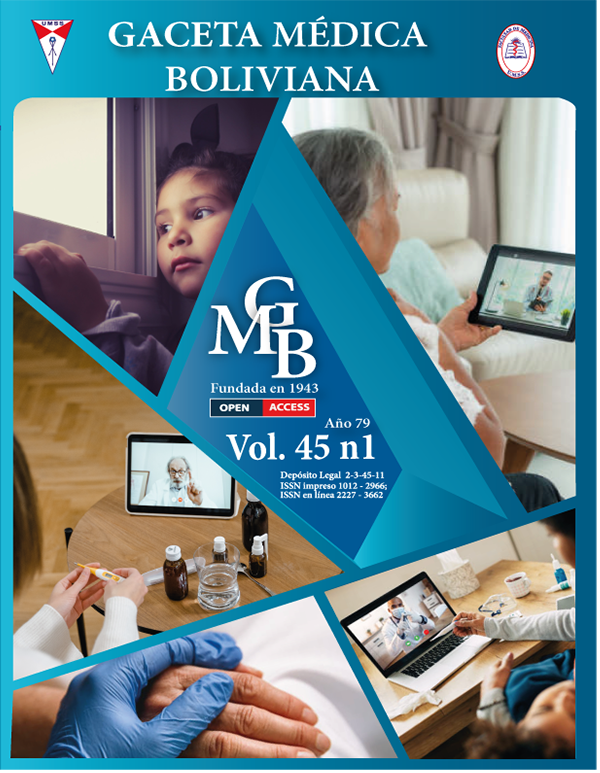Autologous Femoral Calcar Graft as a Buttress for Arthroplasty in Lateral hip Fractures
DOI:
https://doi.org/10.47993/gmb.v45i1.232Keywords:
hip replacement arthroplasty, hip fractures , bone transplantationAbstract
Hip fractures represent an important cause of morbimortality in the adult population, more than 50% correspond to lateral fractures, and these include unstable fractures that are difficult to manage.
Objective: to analyze the clinical and radiological results of patients treated with partial hip arthroplasty for transtrochanteric fractures, using autologous femoral calcar graft.
Methods: prospective study with a quantitative approach. The sample consisted of 11 patients with transtrochanteric hip fracture, who underwent arthroplasty using a femoral calcar graft, with a follow-up of 4 to 6 months, at the Hospital Obrero N°2 of Cochabamba. Clinical and radiological characteristics were analyzed and a description of the surgical technique was made.
Results: the average age of the study population was 83.4 years, with 63.6% female (7 patients) and 36.4% male (4 patients). According to the AO classification for lateral hip fractures, type 31A2.2 was the main one with 45.5%. More than 50% of the patients had good stability according to the Gruen zones. More than 60% evolved between good and excellent, according to the Harris scale, with an average of 83.65 (range from 67.1 to 90.8) at the third month and an average of 84.74 at the sixth month.
Conclusions: we believe that the treatment of lateral hip fractures using this technique can be an alternative for the management of patients with unstable fractures, with a high probability of osteosynthesis failure and mainly when the patient and relatives agree with the procedure.
Metrics
References
Charles-Lozoya S, J. Treviño-Pérez, and J. M. Rangel-Flores. "Aspectos clínico-epidemiológicos y terapéuticos en los pacientes con fractura de cadera." Acta Ortop Mex 27.6 (2013): 375-9.
Peredo Lazarte A. Evaluación clínicoradiológica de fracturas transtrocantéricas de cadera tratados con sistema DHS. Gaceta Médica Boliviana. 2019; 42.2: 139-143.
Riemen Anna HK, and Hutchison JD. The multidisciplinary management of hip fractures in older patients. Orthopaedics and trauma. 2016;30.2: 117-122.
González I, et al. Fracturas de cadera: satisfacción posquirúrgica al año en adultos mayores atendidos en Méderi-Hospital Universitario Mayor, Bogotá, DC. Revista Ciencias de la Salud. 2016; 14.3: 411-424.
Müller F, et al. Total hip arthroplasty for hip fractures: time to surgery with respect to surgical revision, failure, and mortality. Geriatric orthopaedic surgery & rehabilitation. 2019; 10: 2151459318818162.
Dailiana Z, et al. Surgical treatment of hip fractures: factors influencing mortality. Hippokratia. 2013; 17.3: 252.
Roberts, Karl C., et al. "Management of hip fractures in the elderly." JAAOS-Journal of the American Academy of Orthopaedic Surgeons 23.2 (2015): 131-137.
Roselló, Luis Alberto, et al. "REEMPLAZO TOTAL DE CADERA MONOBLOCK EN FRACASO DE OSTEOSÍNTESIS DE FRACTURAS LATERALES." Hospital Privado de Comunidad 18.1 (2015).
Chang, Shi-Min, et al. "Fracture reduction with positive medial cortical support: a key element in stability reconstruction for the unstable pertrochanteric hip fractures." Archives of orthopaedic and trauma surgery 135.6 (2015): 811-818.
Teague, David C., et al. "What’s new in orthopaedic trauma." JBJS 98.13 (2016): 1142-1149.
Cruz-Vázquez, F. J., De la Rosa-Aguilar, and C. A. Gómez-López. "Evaluación del vástago de cadera «Mayo» no cementado. Los primeros 10 años." Acta Ortopédica Mexicana 25.2 (2011): 108-113.
Samelson, EJ, Zhang, Y, Kiel, DP, Hannan, MT, Felson, DT. Effect of birth cohort on risk of hip fracture: age-specific incidence rates in the Framingham Study. Am J Public Health. 2002;92(5):858–862
Nemes, Szilard, et al. "Relative survival following hemi-and total hip arthroplasty for hip fractures in Sweden." BMC Musculoskeletal Disorders 19.1 (2018): 1-9.
Aparicio, Guillermo. "Prótesis bipolares en fracturas laterales de cadera." Temas libres (2021).
Fernández Á. Estabilidad primaria en prótesis de cadera cementada y no cementada. Diss. Universidad Veracruzana. Facultad de Medicina. Región Veracruz., 2016.
de la Torre González, Diego Martín, Jorge Góngora López, and Juan Carlos Galeana López. "Tratamiento quirúrgico de las fracturas intertrocantéricas de la cadera en el anciano." Trauma. La urgencia médica de hoy 7.2 (2004): 53-58.
Martínez, B. García, et al. "Aflojamiento del componente femoral de prótesis de cadera cementada en el postope-ratorio precoz. A propósito de un caso." Revista Española de Cirugía Osteoarticular 49.260 (2014).
Varley, James, and Martyn J. Parker. "Stability of hip hemiarthroplasties." International orthopaedics 28.5 (2004): 274-277.
Monzón, Daniel Godoy, et al. "Total hip arthroplasty for hip fractures: 5-year follow-up of functional outcomes in the oldest independent old and very old patients." Geriatric orthopaedic surgery & rehabilitation 5.1 (2014): 3-8.
Simesen-De Bielke, H., A. González-Della Valle, and E. A. Salvati. "Vástagos cementados en la artroplastía de cadera: historia y evolución." Acta Ortopédica Mexicana 25.5 (2011): 323-333.
Rincón, J. A., et al. "Eficacia de los restrictores de cemento: estudio experimental y desarrollo de una clasificación." Revista Española de Cirugía Ortopédica y Traumatología (2021).
Downloads
Published
How to Cite
Issue
Section
License
Copyright (c) 2022 Gaceta Médica Boliviana

This work is licensed under a Creative Commons Attribution-NonCommercial-ShareAlike 4.0 International License.





























